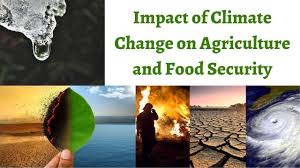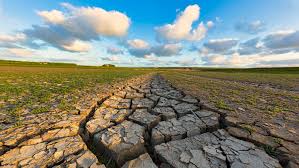The Impact of Climate Change
The Impact of Climate Change on Food Security
What is Climate Change:
Climate Change refers to significant, long-term changes in the average weather patterns on Earth, encompassing alterations in temperature, precipitation, wind patterns, and other climatic factors. While natural processes contribute to climate variability, the term “climate change” is commonly associated with shifts that extend beyond natural patterns, often influenced by human activities. The predominant concern in contemporary discussions is the impact of increased concentrations of greenhouse gases, such as carbon dioxide, in the atmosphere, leading to global warming and associated changes in weather patterns. Human activities, particularly the burning of fossil fuels and deforestation, have accelerated these changes, posing environmental, social, and economic challenges on a global scale.

Climate Change:
Thus, climate Change and Food Security Climate change poses a profound threat to global food security, affecting the production, distribution, and accessibility of essential food resources. The intricate interplay between changing climatic conditions and agricultural systems has far-reaching consequences that impact both developed and developing nations.
Crop Yield Variability:
Impact on Staple Crops: Changes in temperature and precipitation patterns influence the growth and yield of staple crops such as wheat, rice, and corn.
Food Shortages: Consequently, unpredictable weather events contribute to fluctuations in crop yields, leading to food shortages and price volatility.
Water Scarcity and Agriculture:
Irrigation Challenges: Altered rainfall patterns and increased evaporation exacerbate water scarcity, affecting irrigation practices crucial for crop growth.
Vulnerable Regions: Areas dependent on rain-fed agriculture face heightened risks of drought and reduced agricultural productivity.

Shifting Agricultural Zones on Climate Change:
Geographic Displacement: Changing climate conditions force a shift in suitable regions for agriculture, impacting communities reliant on specific crops.
Adaptation Challenges: Farmers and agricultural systems must adapt to new climate realities, presenting challenges in infrastructure and knowledge.
Extreme Weather Events on Climate Change:
Hurricanes and Floods: Extreme weather events like hurricanes and floods can devastate crops, leading to both short-term and long-term food security issues.
Infrastructure Damage: Agricultural infrastructure, such as roads and storage facilities, is susceptible to damage during extreme events.
Livestock and Fisheries:
Impact on Protein Sources: Climate change affects livestock and fisheries, disrupting protein sources for communities.
Economic Challenges: Livelihoods tied to animal agriculture and fishing face economic uncertainties due to changing conditions.

Rising Food Prices:
Supply Chain Disruptions: Climate-related disruptions in agriculture contribute to increased production costs and supply chain challenges.
Economic Inequities: Vulnerable populations are disproportionately affected by rising food prices, intensifying social and economic inequalities.
Vulnerability of Developing Nations:
Limited Adaptive Capacity: Developing nations, often with limited resources, face challenges in adapting agricultural practices to changing climates.
Social and Economic Consequences: Vulnerable populations in these nations bear the brunt of food insecurity, leading to potential social and political instability.
Adaptation and Mitigation Strategies:
Innovative Technologies: Thus, implementation of sustainable and climate-resilient agricultural technologies is essential for adaptation.
Global Cooperation: Consequently, international collaboration is crucial to mitigate the impacts of climate change on global food security. Thus, climate Change and Agricultural Practices Climate change is reshaping traditional agricultural practices, challenging farmers and communities to adapt to new environmental realities. Therefore, the intricate relationship between climate patterns and agriculture has profound implications for global food production, rural economies, and the livelihoods of millions of people.
Temperature Shifts and Growing Seasons:
Warmer Temperatures: Rising temperatures can alter growing seasons, affecting the timing of planting and harvesting.
Heat Stress: Crops and livestock may face increased stress due to extreme heat, impacting yields and animal health.
Changing Rainfall Patterns:
Droughts and Floods: Altered precipitation patterns contribute to more frequent and intense droughts and floods.
Water Management: Farmers must adapt irrigation practices to cope with changing water availability.
Crop Selection and Genetic Modification:
Adaptation Strategies: Farmers may need to shift to crops better suited to new climate conditions.
Genetic Resilience: Research on genetically modified crops that withstand climate stress becomes imperative.

Precision Agriculture and Technology:
Data-Driven Farming: Precision agriculture, utilizing data and technology, helps optimize resource use and enhance productivity.
Drones and Sensors: Monitoring tools aid in early detection of crop diseases and stress, allowing timely intervention.
Agroforestry and Sustainable Practices:
Diversification: Agroforestry practices promote diversification, enhancing resilience against climate-induced shocks.
Soil Health: Sustainable farming practices focus on soil health, which is crucial for maintaining productivity in changing climates.
Water-Efficient Irrigation:
Drip Irrigation: Water-efficient irrigation systems reduce water wastage and help address water scarcity issues.
Rainwater Harvesting: Capturing rainwater becomes essential for supplementing irrigation needs during dry periods.
Cover Crops and Crop Rotation:
Soil Conservation: Cover crops and crop rotation improve soil structure, preventing erosion and enhancing resilience.
Pest and Disease Control: Diverse crop rotations can help control pests and diseases without heavy reliance on chemicals.

Community-Based Adaptation on Climate Change:
Knowledge Sharing: Communities share traditional knowledge and practices for adapting to changing climate conditions.
Collaborative Solutions: Cooperative farming and community-based adaptation initiatives strengthen resilience.
Government Policies and Support to recover climate change losses:
Incentives: Consequently, governments play a crucial role in providing incentives for adopting climate-resilient agricultural practices.
Insurance Schemes: Thus, implementing insurance schemes helps farmers recover from climate-related losses.
Education and Training about Climate Change:
Capacity Building: Thus, training programs and educational initiatives enhance farmers’ capacity to adapt to changing conditions.
Research and Development: Consequently, continued investment in research is essential for developing adaptive technologies and practices.
Conclusion:
Thus, in the intersection of climate change and food security, the stakes are high, and the consequences are palpable. So,the warming climate disrupts agricultural practices, threatening staple crops, water availability, and livelihoods worldwide. While innovative agricultural approaches and international collaboration offer glimmers of hope, the urgency to address climate change’s root causes is paramount. Therefore, the economic, social, and humanitarian costs of inaction are profound, emphasizing the need for immediate, concerted efforts to build resilient food systems that can withstand the challenges of a changing climate. The trajectory we choose today will determine not just the future of food security but the sustainability of life on our planet.
